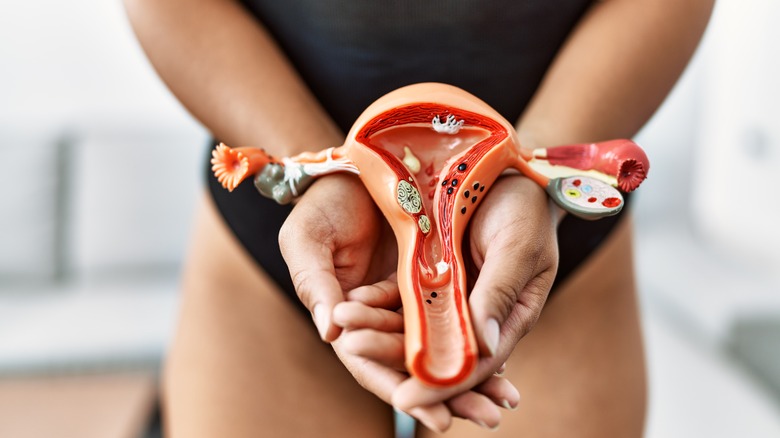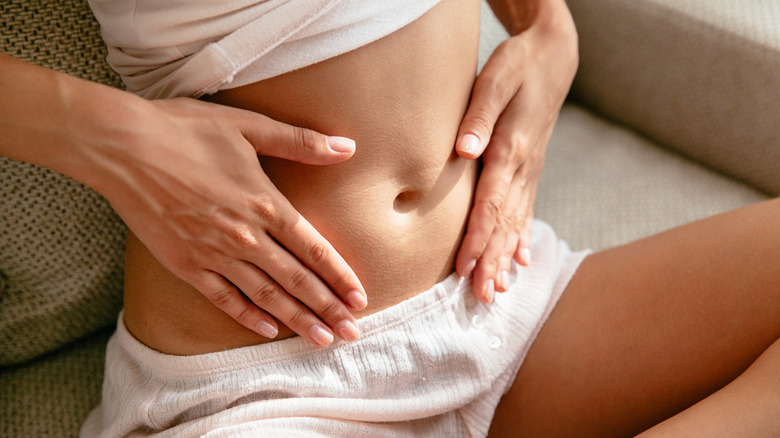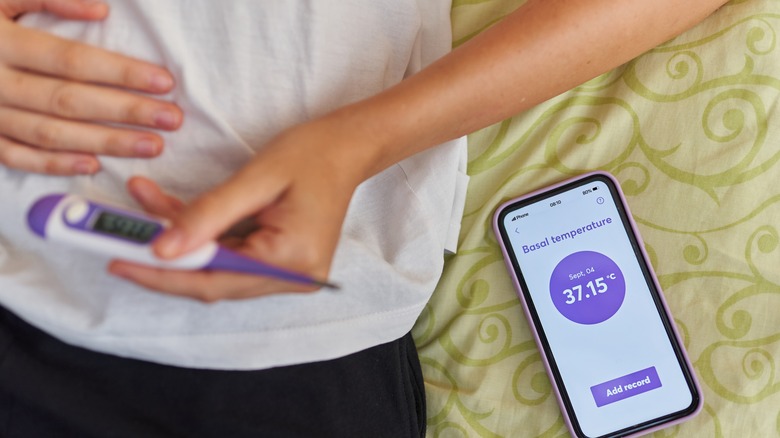Pinpointing Where You Are In Your Menstrual Cycle Is A Mystery No Longer
The menstrual cycle can tell you a great deal about your overall health, and it is even connected to your physical and mental well-being. There are many bodily processes that take place during each of the four phases of the menstrual cycle, and this causes various changes to occur within your body.
For instance, many people associate cramping and bloating with menstruation. However, you can also experience bloating during the luteal phase, the fourth phase of the menstrual cycle, where you may notice symptoms of premenstrual syndrome (PMS) as you approach your period. You may also notice that you have higher energy levels during certain phases of your menstrual cycle, while you experience low energy levels and fatigue around the time of menstruation.
Understanding the four phases of the menstrual cycle — menstrual, follicular (proliferative), ovulation, and luteal — allows you to identify where you are in your menstrual cycle. Having this awareness can help you determine when you are the most fertile, for example, so you can schedule your hot dates accordingly. On the other hand, if you are someone who experiences extreme PMS symptoms, then you can also track your menstrual cycle to predict troublesome symptoms before they begin.
Take a look at these key cycle indicators so you can determine where you are in your menstrual cycle.
Why is it important?
It is important for anyone who menstruates to have a thorough understanding of the menstrual cycle. Not only is the menstrual cycle a notable marker of health, but it also tells you what you need to know in regards to both conceiving and avoiding pregnancy. For instance, if you are able to identify the various stages of your menstrual cycle, such as ovulation, you can easily plan activities around this critical stage of your cycle.
There are other benefits to understanding where you are in your menstrual cycle, and one of these surprising benefits can even help you reach your gym goals. Yes, your muscle gains may also be affected by the menstrual cycle. Specifically, there are certain stages where you might be more likely to notice improvements in muscle mass. Your energy levels also come into play here; you might notice that your body has less energy to spare towards physical activity during the menstrual and luteal phases (via Ovia Health).
Developing an awareness of your menstrual cycle can also help you better understand other symptoms such as anovulation (missed ovulation) or irregular bleeding patterns including missed periods, heavy bleeding, bleeding outside of menstruation, etc. These symptoms can be indicative of hormonal imbalance, chronic stress, or certain health conditions, which is why it is important to make note of symptoms during the four stages of the menstrual cycle, which include the menstrual, follicular (proliferative), ovulation, and luteal phases.
The menstrual cycle
The menstrual phase (in other words, your period) is when the uterine lining sheds if the egg from the last cycle was not fertilized (via Healthline). This phase typically lasts between three to seven days, and you may notice symptoms such as cramping, bloating, mood swings, headaches, tender breasts, and fatigue.
During the follicular phase, which also starts on the first day of your period, your ovaries start producing follicles. When one follicle starts to mature, your uterine lining thickens. This phase lasts approximately 16 days, though it varies. After your period ends, you may notice a surge of energy during this phase, so it may be the ideal time for exercise and movement.
The third phase of the cycle is ovulation, which is when the ovary releases a mature egg that then travels to the uterus. If the egg meets sperm, then pregnancy can occur. For those with a 28-day cycle, ovulation typically takes place around day 14.
Ovulation itself lasts around 24 hours, but since sperm can survive up to five days within the body, it's possible for an egg to be fertilized if you have sex within five days prior to ovulation (or on the day of ovulation). You may notice high energy levels during this phase, per Ovia Health.
The luteal phase, which follows ovulation, lasts between 11 to 17 days. A structure called the corpus luteum will help maintain the uterine lining for implantation and pregnancy. If you don't get pregnant, this structure will shrink away near the end of your cycle, and you may notice symptoms of premenstrual syndrome (PMS), including mood changes, bloating, food cravings, etc. You may also experience lower energy and irregular sleep patterns.
Cervical mucus
The fluid released from your cervix changes in appearance, volume, consistency, and texture depending on the specific stage of the menstrual cycle. These changes are facilitated by fluctuations in hormone levels, and they can help you understand where you are during your cycle.
For instance, several days after your period ends you should notice your cervical mucus is white, sticky, and dry (via the Cleveland Clinic). As your follicular phase continues, you may notice the discharge become creamy, cloudy, and wet.
Immediately prior to the ovulation phase, the cervical mucus may be slippery, stretchy, very wet, and similar to raw egg whites. This will last throughout ovulation. Typically, wet and slippery discharge points to fertility.
After ovulation, however, your cervical discharge may be thick, dry, or sticky which indicates less fertile mucus. You may not notice large amounts of cervical fluid during the luteal phase.
You can check your cervical mucus by looking in your underwear, wiping your vaginal opening with toilet paper, or putting a (clean) finger in your vagina and looking at the mucus.
Cervical position
In addition to fluid excretion, the cervix also changes in position throughout the four stages of the menstrual cycle, which helps you to determine where you are in your cycle. During the menstrual phase, the cervix sits lower in your vagina, according to Ovia Health, and it will be firm to the touch. The opening to your cervix, also known as the internal os, will also open to allow the release of blood.
The internal os will close as your cycle shifts out of the menstrual phase, and the cervix will start to slowly ascend within the vagina. However, if you gently insert a clean finger into your vagina, you may still feel the cervix during this phase. As the follicular phase nears its end, the cervix will continue to rise and become softer, leading up to ovulation.
During ovulation, the cervix will rise further, open up, and become moist to make it easier for sperm to travel. At this point in the menstrual cycle, you may not be able to feel the cervix, as it will be at its highest point.
In the last stage of the cycle, the luteal phase, the cervix moves lower once again and the os will close and become firm. If successful fertilization occurred, however, then your cervix will remain high and soft — with the exception of a closed os.
While your cervical position can offer helpful hints as to where you are in your menstrual cycle, you should pair it with other methods to get the most accurate idea of whether or not you're ovulating.
Basal body temperature
Your body's temperature can also help indicate where you are in your cycle. Changes in basal body temperature are caused by fluctuations in hormone levels. To test your basal body temperature, you must take your temperature immediately upon waking in the morning — before you even get out of bed — for an accurate reading. You should invest in a digital thermometer, or a thermometer specifically geared toward measuring basal body temperature.
If you want to use your body temperature to determine where you are in the menstrual cycle, then you should get into the habit of checking and noting your temperature every day so you can observe your average range. This way, you can observe the subtle shifts in temperature that occur during ovulation where you will notice a slight increase in temperature of up to half a degree from your average range, per UNC Health.
You're likely to be most fertile in the days leading up to the increase in temperature. After the increase in temperature has remained for three days in a row, it's likely you're no longer fertile.
You'll need to track your temperature for a few months to be able to predict when you will ovulate. You should also keep in mind that other factors besides the menstrual cycle can also affect your temperature.
Therefore, it is not generally recommended to rely on the basal body temperature method alone for detecting ovulation. This method should be used in tandem with another method for an accurate prediction.
Ovaries
At a certain point during ovulation, some individuals report feeling pain or discomfort in the lower abdominal region that is referred to as mittelschmerz, which is German for "middle pain" (via the Mayo Clinic). Mittelschmerz describes a sharp, dull, or achy sensation on one side of the belly that may be accompanied by spotting. This pain is typically felt on the side where your ovary is releasing an egg, so the exact area may change between the left and right sides.
Experts don't know the exact cause of mittelschmerz, and it is not experienced by all individuals who menstruate. Although uncomfortable, this phenomenon can help you predict when you will ovulate or if you are currently ovulating.
Regardless of which method you choose to use, the best way to pinpoint where you are in your menstrual cycle is to rely on multiple methods, as opposed to simply one way of tracking your cycle. You can also use popular cycle apps such as Clue, Flo, or Natural Cycles (which is FDA-approved for pregnancy prevention) to track symptoms and predict ovulation.
Keep in mind that if you're trying to prevent pregnancy, then tracking your cycle may be less effective than other methods of birth control. On the plus side, it is relatively affordable and has no side effects.






